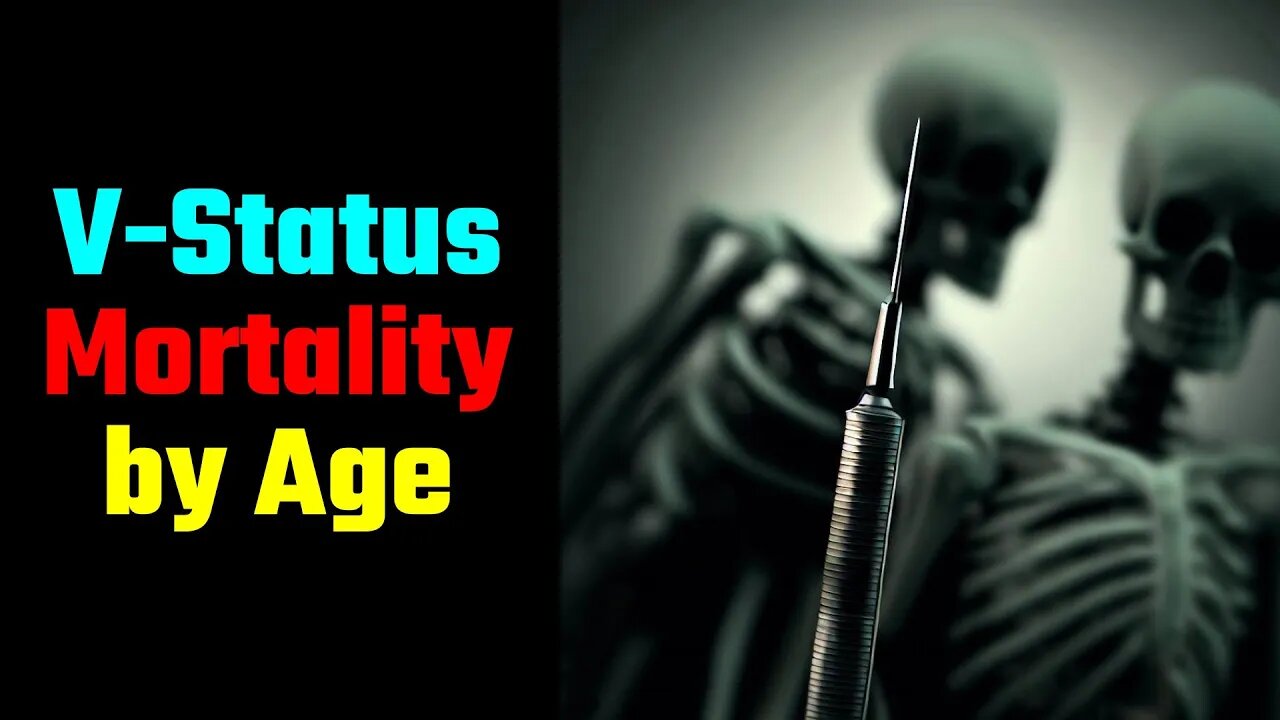Premium Only Content

V-Status by Age UK Final Report
In this presentation, we’ll be looking at v-status mortality by age category as requested by some viewers. This is somewhat of a continuation from my last video. The data we’ll be using is from the UK’s Office for National Statistics Deaths involving [something] by v-status. According to their notices, they will not be publishing this data anymore. I will be downloading their spreadsheet file on Age-standardised mortality rates. Specifically, we’ll be looking at Table 2, mortality rates by v-status by age group, all-cause mortality, which includes falls, illness, cancer, everything. The columns we’re interested in are V-status, Age-standardised mortality, and Age group, noting that the youngest age group is 18-39 year-olds. There are no children in this data, which wasn’t always the case. For example, in their report dated 24 September 2021, they used to include people as young as 10 in a much broader category of 10-59 year-olds, but that’s since gone by the wayside.
Anyway, let’s get started. Here’s the youngest age category, 18-39 year-olds. As usual, let’s begin with the unveed control group shown in blue. A viewer asked to include confidence limits, so I will include the 95% confidence interval shown as thin blue lines, just for the control group. Let’s add first dose recipients, who had their dose more than 21 days ago. If anything, they have slightly higher mortality than the control group, remember, there could be other hidden factors. Also, remember that these are all relatively young people, so naturally, their mortality is going to be quite low anyway. For those who had a second dose at least 21 days ago, I would suggest their all-cause mortality is lower than the control group on average. Third dose individuals who had their dose at least 21 days ago, also seem to have a lower mortality. But the surprising one, I suppose, is the fourth dose individuals who have a much higher mortality than the other groups at six or seven or more times the mortality rate. Remembering, there could be hidden variables at play here. Just one example, which is just speculation on my part, young people who are likely to take a fourth dose might already be quite sick from some other cause, but as I said, that’s just speculation and is not verifiable in this data. But from this view, you can see that young people in general, have low overall mortality.
For young people’s mortality during the first 21 days after taking a dose, there just isn’t that much data, but you can take a look at the overall mortality across all age groups during the first 21 days in my previous video as shown on screen here.
Okay, let’s take a look at the 40-49 year-olds, my age category. Just to make it easier for myself, I’ll show all the data on the one graph, noting that all of these are all-cause mortality 21 days after taking a dose. First dose individuals have a significantly higher mortality than the control group. Those who took a second dose start out having less mortality than the control, but from 2022 onwards, have very similar mortality. According to this data, third dose individuals have less mortality than the control. But again, people in their 40s who took a fourth dose have significantly higher mortality, especially in the first few months of the rollout.
For people in their 50s, obviously, the mortality rates are going to be higher as people get older. First dose recipients had a couple of months of low mortality in early 2021, but their mortality skyrocketed and stayed high ever since. As previously seen, second dose individuals start out having less mortality, but from 2022 onwards, have very similar mortality to the control group.
And our final group, the UK’s most senior citizens, 90-years-old and above. As you can see, first dose recipients had an extremely high mortality rate in the beginning, peaking at around 80% death rate in June 2021. Second dose recipients also had a similar peak with a mortality rate over 70,000 per 100,000. Third dose recipients started off well, but by mid-2022, were significantly worse than the control group, with fourth dose individuals pretty much tracking the control group mortality. So basically, all-cause mortality for the control group remained pretty steady between 2021 and 2023, but that can’t really be said for first and second dose.
Anyway, that’s the last ever report on v-status mortality coming out of the UK, at least, for this period of history. I hope you enjoyed this presentation, but more importantly, I hope that society at least learns something from these last two years of observations.
OFFICE OF NATIONAL STATISTICS – DEATHS BY V-STATUS, ENGLAND
https://www.ons.gov.uk/peoplepopulationandcommunity/birthsdeathsandmarriages/deaths
MUSIC
Allégro by Emmit Fenn
-
 6:36
6:36
Daily Insight
8 months agoConflicting Unborn Child Laws in Australia
2533 -
 12:15
12:15
Nikko Ortiz
12 hours agoMonday Gun Fails
2.44K4 -
 2:10:32
2:10:32
Side Scrollers Podcast
16 hours agoStreamer Nearly Beats A Man to Death on Stream + Twitch Viewership PLUMMETS + More | Side Scrollers
2.57K4 -
 13:09
13:09
Forrest Galante
1 day agoWildlife Expert Reacts To Deadly Australian Animal TikToks
70.6K13 -
 23:47
23:47
GritsGG
2 days agoThe Forgotten Best Sniper Support AR!
23.1K4 -
 10:18
10:18
The Pascal Show
15 hours ago'I WILL NOT GIVE UP ON MY BABY!' Emmanuel Haro's Mom Breaks Silence From Jail?!
32 -
 LIVE
LIVE
Lofi Girl
2 years agoSynthwave Radio 🌌 - beats to chill/game to
248 watching -
 2:33:04
2:33:04
Badlands Media
12 hours agoBaseless Conspiracies Ep. 147: Pole Shifts, Plasma Skies, and the Truth About Cataclysms
145K17 -
 4:33:42
4:33:42
Drew Hernandez
8 hours agoISRAEL BOMBS GAZA HOSPITAL ON LIVE TV KILLING AT LEAST 20 INCLUDING JOURNALISTS & CIVILIANS
17K19 -
 2:55:23
2:55:23
TimcastIRL
7 hours agoTrump Orders Specialized National Guard Units To Combat Crime In Cities, Dems Furious | Timcast IRL
196K140